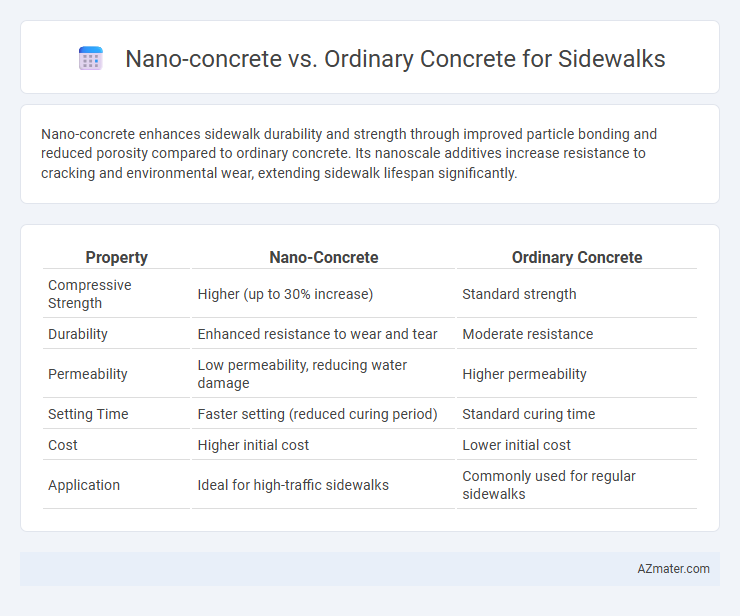Nano-concrete enhances sidewalk durability and strength through improved particle bonding and reduced porosity compared to ordinary concrete. Its nanoscale additives increase resistance to cracking and environmental wear, extending sidewalk lifespan significantly.
Table of Comparison
| Property | Nano-Concrete | Ordinary Concrete |
|---|---|---|
| Compressive Strength | Higher (up to 30% increase) | Standard strength |
| Durability | Enhanced resistance to wear and tear | Moderate resistance |
| Permeability | Low permeability, reducing water damage | Higher permeability |
| Setting Time | Faster setting (reduced curing period) | Standard curing time |
| Cost | Higher initial cost | Lower initial cost |
| Application | Ideal for high-traffic sidewalks | Commonly used for regular sidewalks |
Introduction to Nano-Concrete and Ordinary Concrete
Nano-concrete incorporates nanoparticles such as nano-silica and nano-titanium dioxide to enhance mechanical properties, increase durability, and reduce porosity compared to ordinary concrete. Ordinary concrete, composed mainly of cement, aggregates, water, and admixtures, provides standard strength and durability suitable for most sidewalk applications but is prone to microcracking and weathering over time. The integration of nanomaterials in nano-concrete leads to a denser microstructure and improved resistance to environmental degradation, making it a superior choice for long-lasting sidewalks.
Key Material Properties: Nano-Concrete vs Ordinary Concrete
Nano-concrete exhibits significantly enhanced compressive strength and tensile strength compared to ordinary concrete, resulting from its improved particle packing and reduced porosity. The incorporation of nanoparticles, such as nano-silica, increases the material's durability, resistance to freeze-thaw cycles, and chemical attack, making it ideal for sidewalk applications exposed to harsh environmental conditions. Nano-concrete also demonstrates superior microstructure refinement and higher density, which contribute to its enhanced abrasion resistance and longevity over traditional ordinary concrete.
Strength and Durability Comparison for Sidewalk Applications
Nano-concrete exhibits significantly higher compressive strength and enhanced durability compared to ordinary concrete, making it ideal for sidewalk applications exposed to heavy foot traffic and environmental stressors. The incorporation of nanoparticles refines the microstructure, reducing porosity and improving resistance to wear, freeze-thaw cycles, and chemical attacks. Studies show nano-concrete sidewalks maintain structural integrity longer, reducing maintenance costs and extending service life compared to traditional concrete mixtures.
Workability and Setting Times Explored
Nano-concrete enhances workability compared to ordinary concrete due to the reduced particle size of nanoparticles, which fill microvoids and improve flowability and compaction. Setting times in nano-concrete are accelerated as nanoparticles act as nucleation sites, promoting faster hydration and early strength development. This leads to shorter curing durations and improved performance in sidewalk applications where rapid hardening and durability are critical.
Resistance to Cracking and Weathering
Nano-concrete exhibits superior resistance to cracking and weathering compared to ordinary concrete due to its enhanced nanoparticle dispersion, which improves the matrix density and reduces microcrack formation. The integration of nanoparticles such as silica or titanium dioxide increases durability by minimizing permeability and enhancing resistance to freeze-thaw cycles and chemical attacks typical in sidewalk environments. This results in longer-lasting sidewalks with reduced maintenance costs and improved structural integrity under varying weather conditions.
Cost Analysis and Economic Considerations
Nano-concrete incorporates nanoparticles that enhance durability and reduce maintenance costs compared to ordinary concrete, leading to long-term economic benefits despite a higher initial investment. The improved mechanical properties of nano-concrete decrease repair frequency for sidewalks, thus lowering lifecycle expenses and downtime. Cost analysis reveals that while ordinary concrete has lower upfront costs, nano-concrete's extended lifespan and reduced repair needs provide a more cost-effective solution for pedestrian infrastructure over time.
Environmental Impact and Sustainability Factors
Nano-concrete significantly reduces the environmental footprint of sidewalks by incorporating nanoparticles that enhance strength and durability, leading to longer service life and less frequent repairs compared to ordinary concrete. Its improved hydration processes lower cement consumption, thereby decreasing CO2 emissions associated with production. The sustainability benefits include better resistance to weathering and chemical attacks, resulting in reduced material waste and lower resource depletion over time.
Installation and Maintenance Requirements
Nano-concrete offers a faster installation process for sidewalks due to its superior flowability and self-compacting properties, reducing labor time by up to 30% compared to ordinary concrete. Its enhanced durability and resistance to microcracking significantly lower maintenance needs, cutting repair frequency and costs over the lifespan of the sidewalk. Ordinary concrete requires more labor-intensive finishing and frequent sealing or patching to address surface wear and environmental damage.
Case Studies: Sidewalk Projects Using Nano-Concrete
Case studies reveal that sidewalks constructed with nano-concrete exhibit enhanced durability and resistance to cracking compared to ordinary concrete, contributing to longer service life under heavy pedestrian and vehicular traffic. Projects in urban areas like Chicago and Tokyo demonstrate nano-concrete's superior performance in freeze-thaw cycles and reduced maintenance costs due to its nano-silica content improving bonding and microstructure. These empirical findings confirm nano-concrete as a sustainable choice for sidewalk applications with increased load-bearing capacity and environmental resilience.
Future Prospects and Recommendations for Sidewalk Construction
Nano-concrete offers enhanced durability, higher tensile strength, and improved resistance to environmental factors compared to ordinary concrete, making it a promising material for future sidewalk construction. Its ability to reduce micro-cracking and extend service life aligns with sustainability goals and lowers maintenance costs over time. Future projects should prioritize incorporating nano-concrete in sidewalks to leverage these benefits while conducting long-term performance studies to optimize mix designs and application methods.

Infographic: Nano-concrete vs Ordinary concrete for Sidewalk
 azmater.com
azmater.com